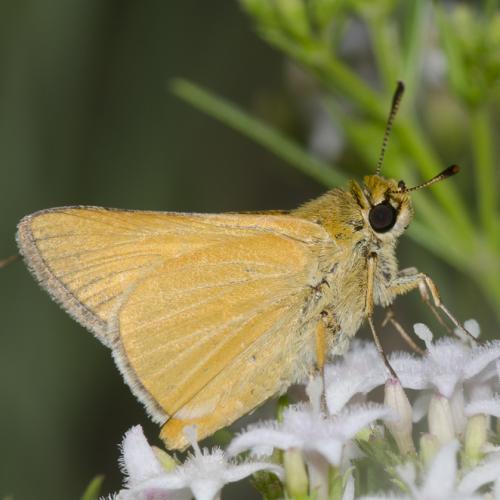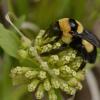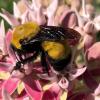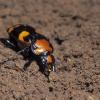
The arogos skipper is scattered in isolated populations across much of the United States west of the Rockies, but in no location can it be considered secure. Estimates put its population decline at 99-100 percent in most of its range. East of the Mississippi it is extirpated from much of its range: its stronghold is New Jersey, where it is state-listed as Endangered. It is reliant on relatively undisturbed prairies and grasslands, a habitat that has suffered badly from development and agricultural conversion. Surviving populations of the skipper are susceptible to frequent fires and pesticide use.
The arogos skipper is a small butterfly in the family Hesperiidae (skippers). Its wingspan is between 1 1/8 and 1 7/16 inches (29 to 37 mm). The upperside of the wings is yellow-orange with black borders which are wider in females. Underside of hindwing is yellow with paler veins.
Taxonomic Status
(Lepidoptera: Hesperiidae: Hesperiinae)
Atrytone arogos (Boisduval & LeConte), 1834. There are two subspecies, A. a. arogos and A. a. iowa.
There are two broods between April and September in the south and one in June and July in the north. In prairie regions, the hostplant is usually big bluestem (Andropogon gerardii) and sometimes little bluestem (Schizachyrium scoparium). Hostplants vary elsewhere, including pine barren sandreed (Calamovilfa brevipilis) in Carolina pine barrens and lopsided Indiangrass (Sorghastrum secundum) in Florida.
Males perch on low vegetation near to larval hostplants to wait for females. Females lay eggs singly under hostplant leaves. Caterpillars feed on leaves and live in tent s of two leaves silked together. Fourth-stage caterpillars hibernate, complete their feeding the next spring, and pupate in a leaf cocoon in vegetation about three feet above the ground.
The historic distribution included most of the states west of the Rockies (it was not recorded in a cluster of states below the Great Lakes, in the Appalachians, nor in New England), although occurrences were widely scattered and isolated colonies were recorded in only around two hundred counties. Subspecies iowa occupies the western part of the range and subspecies arogos is found in the east.
Current distribution is more limited and it is probably extirpated from most of its locations east of the Mississippi and many of those to the west.
The arogos skipper is reliant on relatively undisturbed prairie and grassland habitats through most of its range. The exception appears to be in New Jersey, where it is found on highly disturbed fields and rights-of-way, although these are mostly remnants of sand prairies.
Xerces Red List Status: Vulnerable
Other Rankings:
Canada – Species at Risk Act: N/A
Canada – provincial status: N/A
Mexico: N/A
USA – Endangered Species Act: None
USA – state status: IL, NJ, NY: Endangered
MN: Threatened
IA: Species of Concern
NatureServe: G3
IUCN Red List: N/A
The arogos skipper is scattered in isolated populations across much of the United States east of the Rockies, however it is in severe decline in almost its entire range. The eastern subspecies, A. a. arogos, has disappeared from most of its recorded locations east of the Mississippi and is barely surviving at the remaining locations. The current stronghold for this subspecies is New Jersey, where it is state-listed as Endangered. The western subspecies, A. a. iowa, is faring better, especially in the southern parts of its range, but cannot be considered secure. Overall, the population decline has been estimated as “99- 100% in most parts of the range” (NatureServe).
This butterfly receives no protection federally but is listed by a number of states. In Illinois (Endangered), Minnesota (Threatened), and Iowa (Species of Concern) it is listed as Atrytone arogos. New Jersey and New York both list the subspecies Atrytone arogos arogos as Endangered.
Prairies everywhere have been destroyed or fragmented by agricultural and urban development. Remaining prairies continue to be threatened by agricultural conversion, grazing, and pesticide applications. Management of prairies is also an issue because this butterfly appears to be more sensitive to fire than some other prairie-dependent species. Fire has impacted populations of Arogos Skipper, and in some places it is known to have caused local extirpation. Fire rotations of two years or less appear to severely impact this butterfly. Fire rotations of three years or greater have less impact.
The butterflies prairie and grassland habitats must be protected from development or conversion and management of remaining prairie should be done to minimize the impact of management actions on the butterfly.
Further research is needed into the impacts of fires (particularly the timing of prescribed burns) and the viability of populations on smaller habitat fragments.
Opler, P. A., and G. O. Krizek. 1984. Butterflies East of the Great Plains. Johns Hopkins University Press, Baltimore, MD.
Opler, P. A., and V. Malikul. 1992. A Field Guide to Eastern Butterflies. Houghton- Mifflin Co., Boston, MA.
Scott, J. A. 1986. The Butterflies of North America. Stanford University Press, Stanford, CA.
Stanford, R. E., and P. A. Opler. 1993. Atlas of Western USA Butterflies Including Adjacent Parts of Canada and Mexico. Denver and Fort Collins, CO.
Tilden, J. W. 1986. A Field Guide to Western Butterflies. Houghton-Mifflin Co., Boston, MA.
Profile prepared by Matthew Shepherd, The Xerces Society for Invertebrate Conservation.
Citation
Shepherd, M. D. 2005. Species Profile: Atrytone arogos. In Shepherd, M. D., D. M. Vaughan, and S. H. Black (Eds). Red List of Pollinator Insects of North America. CD-ROM Version 1 (May 2005). Portland, OR: The Xerces Society for Invertebrate Conservation.





